Blog about successful marketing strategies in russia
Programmatic Market Overview and AdTech Services in Russia


DIGITAL MARKETING
Share this Post
In Russia, there is a consistent increase in interest in online media advertising. In particular, the demand for programmatic buying is growing, which allows for the automatic purchase of advertising space on digital platforms.
Last year, programmatic advertising in Russia grew by 21%, reaching $5.7 billion. It accounted for 91.4% of the digital segment, once again proving that automated media buying is now setting the pace in the online advertising market.
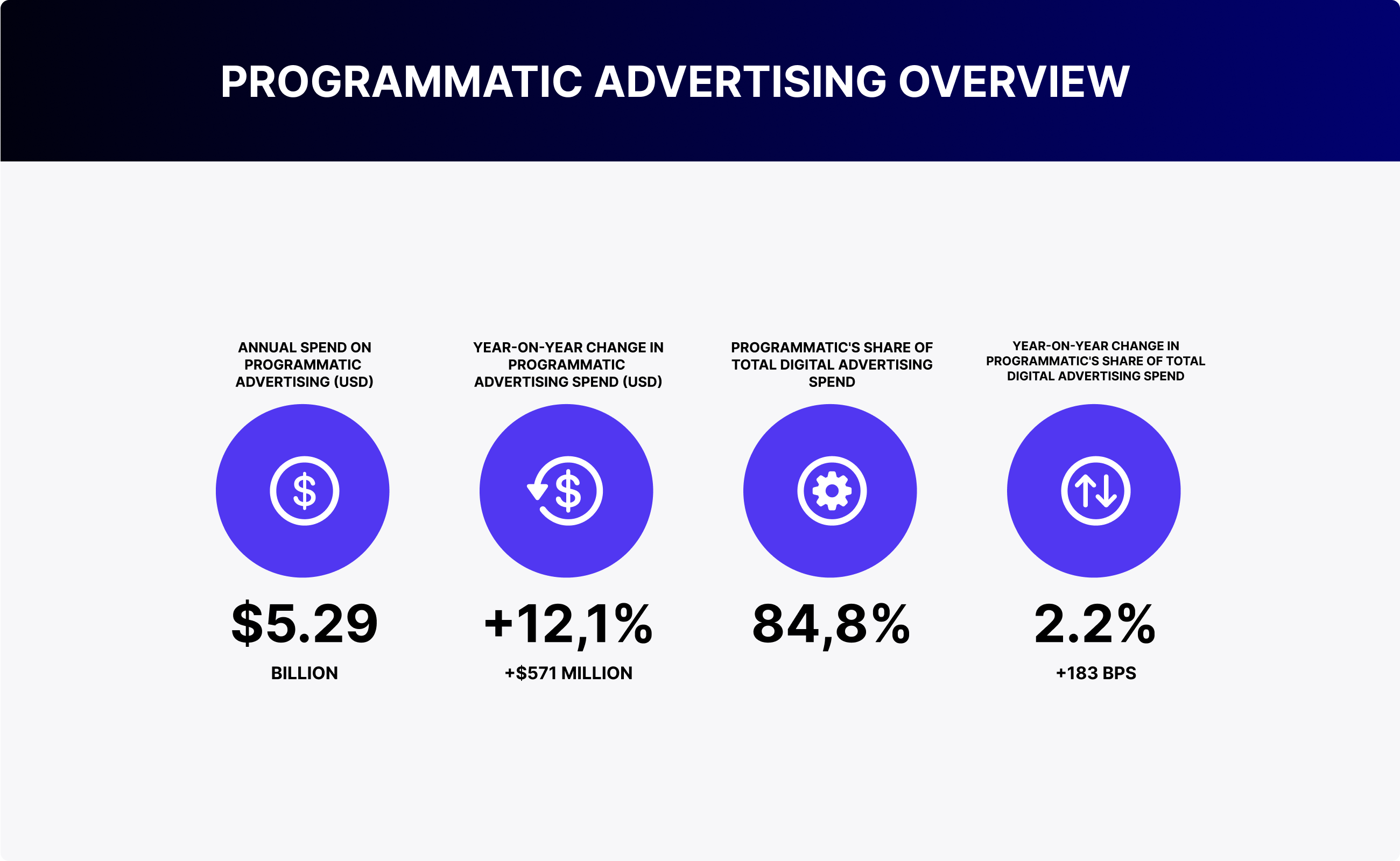
Despite the fact that many Western programmatic platforms ceased operations in Russia — for example, Aitarget (Meta's international partner, provided access to its advertising tools in Russia until 2022) — the Russian market has managed to stabilize through the adoption of new technologies by several companies and a 10–25% increase in media buying costs compared to the previous year.
Programmatic's Influence on Advertising Market Trends
Recent research indicates that the primary avenues through which Russian Internet users become aware of new brands are television advertising (39.2%) and search engines (36.9%). Programmatic platforms enhance the advertising capabilities of these channels. For instance, they can target users with greater precision and display advertisements at optimal times and in suitable contexts. This is particularly crucial for integrations in social networks (25.8%) and mobile applications (16.7%), where personalization and precise targeting are vital for success.
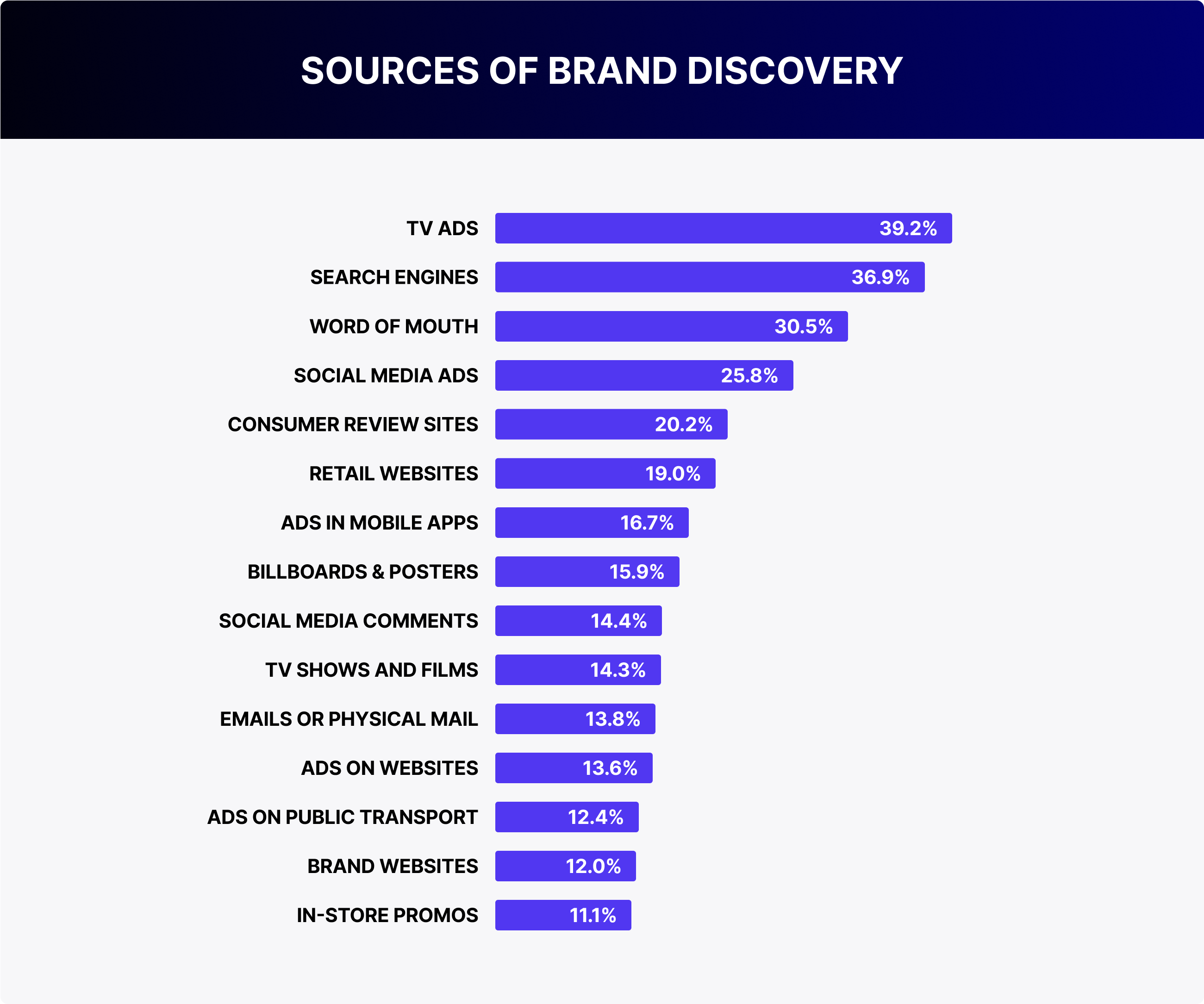
It is important to note that Russian users engage actively with brands through digital channels. 56.3% of respondents indicated that they research brands online before making a purchase, while 29.8% reported visiting brand websites and 7.3% stated that they click on banner ads. Programmatic platforms enable brands to manage these interactions through the use of machine learning algorithms and data analytics. This approach optimizes ad placement and increases engagement rates.
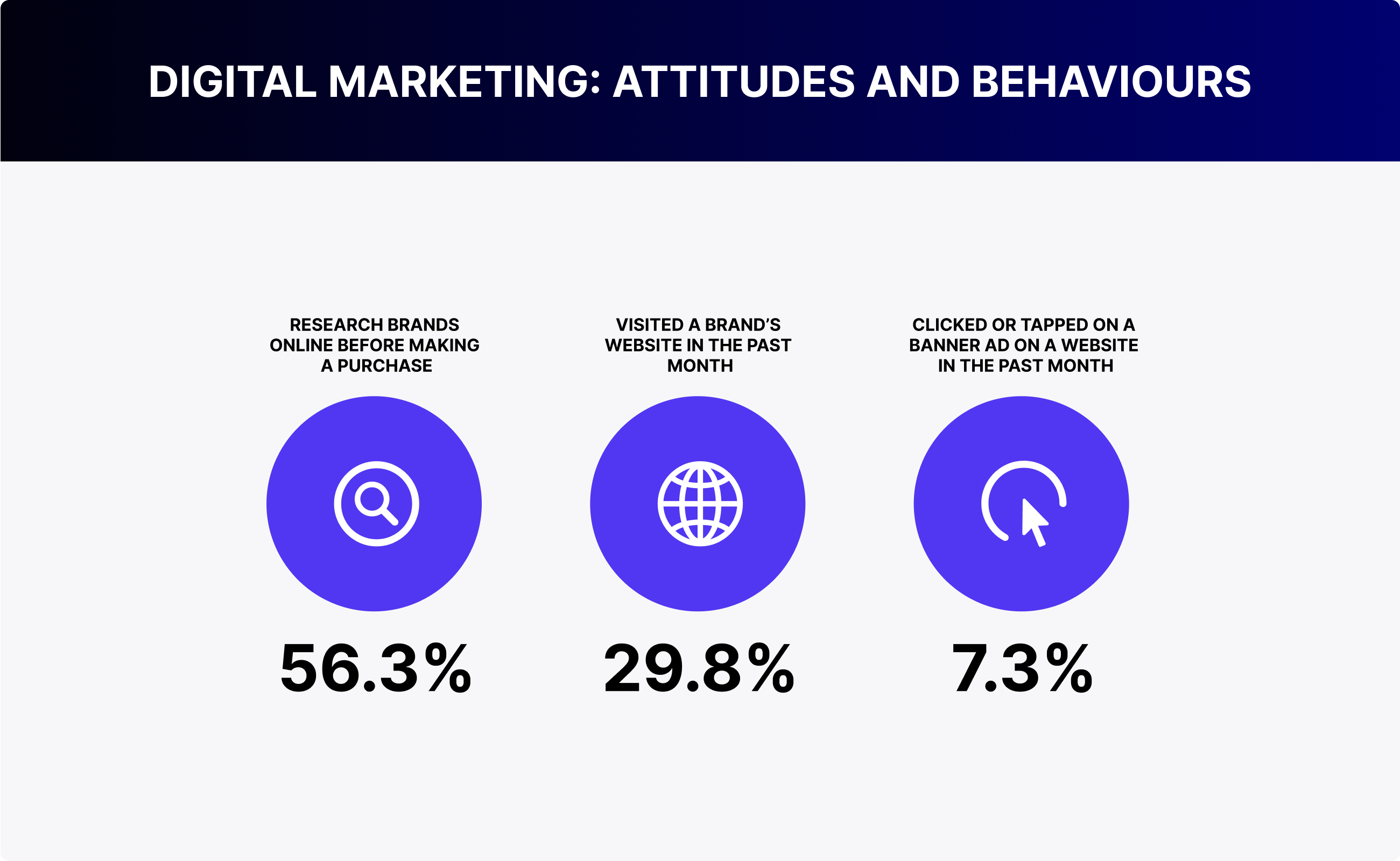
Key Trends in Programmatic Buying
With limited access to international ad tools, Russian platforms are focusing on first-party data and proprietary segmentation algorithms. This has sparked growing interest in DMP solutions within local DSPs.
The cost of purchasing such advertising also represents a significant factor. The current trend is in favor of cheaper sources.
It is important to note that the so-called "fake traffic" phenomenon plays a significant role in this context. The number of it grew by 35% last year. Therefore, brands must improve their ability to track and identify which visitors are "real" and which are "fake" in order to avoid losing money and to enhance the effectiveness of their advertising. Some independent platforms are already implementing anti-fraud technologies and developing improved pre-bid solutions that will help determine the value of inventory (ad space) and whether it's worth paying for, even before the auction begins.
One more effective solution to combat fraud is to use what are known as Traffic Verification Tools. These are fraud protection systems integrated into programmatic platforms (DSPs) as well as specialized services for traffic verification. These tools provide comprehensive monitoring, verification, and protection for digital advertising, enabling brands to safely and effectively engage with their target audiences. Additionally, each service offers a range of supplementary features.
To illustrate, Adriver's digital advertising management and auditing system offers a range of tools, including reports, traffic verification, and the ability to purchase ad impressions in an open auction (Soloway DSP). The Admon.ai service conducts independent traffic audits and searches for potential vulnerabilities on websites. It's an effective tool for increasing traffic visibility, tracking user paths, and eliminating poor-quality metrics. Ultimately, the selection of a traffic verification tool is contingent upon the specific objectives of the campaign, the intended placement sources, and the availability of supplementary resources, if necessary.
In 2025, the trend toward 'sovereign advertising' continues to gain momentum. Independent DSP platforms that operate outside the ecosystems of Yandex, VK, and MTS are taking up a larger share of the market. This shift gives businesses more flexibility when choosing channels and formats, especially in sensitive categories like healthcare, finance, and insurance.
The exit of major global platforms like Google DV360 and The Trade Desk has accelerated the rise of local solutions. Today, over 90% of ad campaigns in Russia are launched through domestic DSPs, including GetIntent, Soloway, Segmento, BYYD, as well as tools embedded within larger ecosystems like VK Ads and Yandex.Direct.
One significant development is the growing role of video advertising and CTV (Connected TV). Video formats — especially short pre-rolls and interactive ads in Smart TV environments and mobile apps — have become key tools for audience engagement. Programmatic buying is now widely used for acquiring video traffic with real-time targeting by interest, device, and user behavior. Platforms like GetIntent, BYYD, and Hybrid are actively expanding their video inventory and capabilities. In 2025, CTV advertising on Smart TVs and OTT platforms is no longer limited to large brands — local DSPs have made it accessible to mid-sized businesses as well.
For instance, GetIntent recently ran a video campaign for a major FMCG brand, placing ads on Smart TVs. The goal was to reach consumers during evening hours at home. The campaign featured pre-rolls targeted at women aged 25–45 interested in family content and cooking.
The brand saw strong results, including a 73% VTR and a measurable lift in brand awareness, according to Brand Lift surveys. This performance was driven by precise frequency management based on user behavior and smart inventory selection powered by GetIntent’s algorithms.
Thus, businesses are turning to programmatic platforms to purchase advertising for a number of reasons. First and foremost, they are highly flexible, enabling rapid adaptation to changes and new trends. This allows for the targeted and personalized display of advertisements, thereby enhancing their efficacy. This process is automated through the use of artificial intelligence and accumulated data. It is a particularly advantageous feature for businesses that may not have the resources or expertise to collect data from their websites and other promotional channels. Programmatic advertising can be used to achieve two key business objectives: increasing brand awareness and generating immediate results.
'Independent' Programmatic Platforms: Why Pay Attention to Them?
Russia boasts a number of independent programmatic procurement platforms that are in high demand due to their transparency, flexibility, and innovative solutions. In this context, "independent" refers to platforms that are not owned by large media holdings or advertising networks. For instance, there is a programmatic platform, such as Segmento, that provides sophisticated targeting and data analysis capabilities. While it is renowned for its transparency and flexibility, it is not an independent entity, as it is part of MTS Ads (a subsidiary of MTS PJSC), which leads the ranking in terms of revenue (1st place).
In 2025, Segmento remains one of the most advanced players in the first-party data space, thanks to MTS’s mobile DMP and deep integration with telecom audiences. However, its affiliation with the MTS ecosystem limits flexibility and narrows the range of available channels.
|
|
|
|
|
|
|
|
|
|
|
|
|
|
|
|
|
|
|
|
|
|
|
|
|
|
|
|
|
|
|
|
|
|
|
|
|
|
|
|
|
|
|
|
|
|
|
|
|
|
|
|
|
|
|
|
|
|
|
|
|
|
|
|
|
|
In addition to Segmento, MTS ads also includes Buzzoola, a platform from which MTS has acquired 67% for the placement of native advertising. The remaining portion will be purchased in due course. The platform offers a unique opportunity to display video ads and text-graphic advertising blocks while users scroll through a website page or news feed. The platform displays advertisements on websites in Russia and CIS countries, reaching a total audience of over 100 million.
MTS Ads reports revenue of 1.33 billion rubles.
In addition to not belonging to large holdings, independent platforms are smaller, which allows them to offer greater flexibility. We can tailor advertising to specific topics and sites, for instance, by displaying ads only on certain thematic pages. Such possibilities are less frequently available on larger platforms, which tend to be more structured and uniform in their approach.
Large advertising platforms have their own inventory or places to advertise, but independent platforms have their own unique placements, such as popular online movie theaters. Such options are not typically available on large resources. Therefore, we may lose a portion of our audience and the most effective advertising platforms if we decline to utilize independent ones.
Review of Perspective Programmatic Platforms with DSP Purchase Model in Russia
Let's take a look at some independent platforms to consider.
Hybrid
HYBRID is an independent programmatic platform ranked among the top 10 in revenue in Russia. It operates outside the major ecosystems like VK, Yandex, and MTS, offering a Self-Service model for agencies and brand digital teams.
The platform focuses on transparent media buying, flexible targeting, rapid campaign launch, and support for all key formats — from banners and video to audio, CTV, and DOOH. HYBRID partners with major media outlets and mobile apps, and is actively expanding into Smart TV and audio advertising remaining one of the few players in the Russian market offering these formats via programmatic.
HYBRID’s dashboard unifies all channels in a single interface — web, mobile, in-app, Smart TV, and digital out-of-home. This enables true omnichannel strategies and consolidated analytics across all touchpoints.
Key platform features include algorithmic optimization across CPC, CPM, CPA, and CTR models, integration with SSPs and DMPs, and access to third-party data sources. Targeting is based on user behavior, interests, geolocation, demographics, and device type. HYBRID offers a fully transparent inventory with detailed insights into placements, pricing, and audience, eliminating the 'black box' issues typical of agency buys. It also includes robust anti-fraud measures and brand safety technology.
One of HYBRID’s standout advantages is its high degree of customization, precise audience targeting, and full control over the entire buying process — from format selection to performance analysis. This is backed by automated analytics and a clear reporting system, making the platform suitable for both experimental pilots and large-scale digital strategies.
A notable example of HYBRID’s impact was a campaign for Dreame, a premium robot vacuum brand. For its New Year promotion in Russia, the team launched CTV video ads across Smart TVs and online streaming platforms. The campaign reached over 1.5 million unique viewers, with a video completion rate above 94%. Thanks to precise targeting by interests and content, the brand boosted both awareness and purchase intent.
This case highlighted how programmatic tools — especially in the Connected TV space — can drive both recognition and conversions, even for niche, high-tech products.
Genius Group
Genius Group has secured the 12th position in the revenue ranking. The platform offers comprehensive strategies for both media advertising (where to place ads) and performance (how to achieve specific results from ads).
Also, you can access their proprietary system or set of technologies here to assist you in selecting placements and conducting additional tests to assess the efficacy of the advertisements.
In addition, the platform provides access to the Genius Production service. We can be assisted with design, branding, website, and video production. They offer a comprehensive range of services to create visually appealing and functional ads and content.
Furthermore, the platform employs a self-service DSP (demand-side platform), enabling advertisers to manage their ad campaigns independently, specifically, to purchase advertisements, select target audiences, set budgets, and track results without the need for intermediaries or agencies. They also set goals and targeting parameters, such as audience demographics, interests, and location.
Genius showcases a range of campaigns across banking products, FMCG brands, and companies with their own mobile apps.
One example is a campaign for a food delivery service aimed at lowering the cost per order in its mobile app. The performance strategy focused on mobile traffic and leveraged look-alike audiences, algorithmic bid optimization, and retargeting tactics.
As a result, the campaign reduced cost per install by 30%, while in-app orders increased by 54%. ROI showed steady growth thanks to precise targeting and segmentation based on behavioral and demographic data.
Between 2024 and 2025, Genius also positioned itself as an active integrator of local media and niche websites, offering clients flexible inventory buying without relying on major platforms.
GetIntent
GetIntent has achieved the eighth position in the revenue ranking. The company also offers a self-service DSP. The platform provides video tutorials and a concise knowledge base to assist users in comprehending the system.
What's on offer?
The platform employs proprietary technologies that facilitate the efficient management of advertisements and analysis of their results. As a result, we are able to reduce our advertising costs. Additionally, AI-powered campaign optimization is integrated into the platform. Artificial intelligence is employed to analyze data and adjust advertisements in order to achieve optimal results.
Additionally, the platform offers a campaign planning tool and Data à la carte. The latter tool enables us to select and utilize data to personalize advertising messages. This allows us to use specific data to customize advertisements, making them more targeted and appealing to different groups of people.
Furthermore, we have the ability to track the performance of ad campaigns in real time, allowing us to make adjustments promptly if necessary.
The brand platform also provides essential security features, including anti-fraud measures, which are crucial for maintaining the integrity and trustworthiness of our operations. This ensures that advertisements are displayed in secure environments and that fraudulent activity is prevented.
Additional platform features include:
-
White Label: This option allows clients to utilize the platform's technology to create and manage ads under their own name and logo.
-
The action predictor is a tool that helps determine which users are more likely to take a targeted action (e.g., purchase) after seeing an ad.
-
GetRewarded. Rewarded video is a mobile advertising format that offers users incentives for viewing, such as bonuses or special offers. These ads are designed to be engaging and enjoyable for users, while also driving profitable engagement for brands.
-
CTV (Connected TV) is a support for video ad placements on Smart TVs and OTT platforms. The platform enables launching ads directly on TV screens with targeting based on geolocation, time of day, and audience interests. This boosts reach and enhances the quality of brand engagement.
GetIntent has a proven track record of success in a diverse range of industries, including banking, FMCG, and pharmaceuticals. GetIntent launched a campaign for a bank aimed at increasing the number of online account applications. To achieve this, the platform used behavioral segments focused on interest in financial services, along with retargeting users who had recently engaged with competitor websites.
Its algorithms selected the most relevant inventory and audiences in real time, improving targeting accuracy and lowering acquisition costs. As a result, registrations increased by 27%, and the CPA came in below the projected benchmark.
Soloway
Soloway is currently ranked sixth in terms of revenue. DSPs self-service is also available here.
They offer automated video and banner advertising using the following tools:
-
Lookalike audiences. This targeting method employs machine learning algorithms to identify new users with characteristics similar to those of existing customers. For instance, this may be done based on demographics, website behavior, and other attributes.
-
Retargeting and dynamic retargeting. Dynamic retargeting represents an advanced form of retargeting that automatically displays personalized advertisements to users based on their previous behavior on the site. This is implemented through DCO (dynamic creative optimization) technology - advertisements adjust to the user's actions in real time.
-
Audience segments. These are groups of users with similar characteristics or behaviors. These segments are created based on data collected from a variety of sources, including demographic information, interests, site behavior, and content interaction.
Soloway offers an advanced programmatic ad-buying technology, Adaptive Formula™, designed to maximize efficiency and budget utilization. How it works?
The Formula™ evaluates each user individually to determine the value of each ad impression. It analyzes behavior, interests, and external display conditions to determine whether each individual display is worth purchasing. It is continuously updated, adjusting parameters based on user behavior. It takes into account a wide range of factors, such as user interest analysis, ad interaction, session characteristics, and external parameters like time, location, device type, and more.
The benefits of this technology are clear:
-
Full coverage of RTB space. It works with any available advertising space and determines the optimal bid for each display, providing the best price/quality ratio.
-
Accurate bid estimation and optimization increase ROI (return on investment).
-
No need to test audiences as Formula™ runs billions of micro-tests, improving performance over time.
-
All you need to do is set goals and KPIs. Formula™ will automatically select the optimal parameters and optimize the campaign.
Soloway doesn’t have published case studies on its website, which makes it difficult to evaluate its performance externally. However, in terms of technical capabilities, the platform ranks among the most advanced independent DSPs in Russia.
BYYD
BYYD is currently ranked 27th in terms of revenue. Self-Service DSP is in full-service mode only. This indicates that users are unable to manage campaigns independently via the platform interface, but instead require assistance from platform experts. Full-service DSPs offer a more comprehensive and personalized service. This can be particularly beneficial for companies lacking the resources or expertise to manage campaigns independently.
The platform is utilized for the purpose of procuring advertising traffic on smartphones and tablets within mobile apps. Additionally, clients may avail themselves of banner and video creation services, as well as detailed analytics and reports on the performance of advertising campaigns.
С 2025 года BYYD делает акцент на интерактивных форматах — от rewarded video до геймифицированных баннеров с вовлечением в рекламный сюжет.
Let’s look at a case to see how the platform operates in practice.
Wheel rim manufacturer SKAD partnered with BYYD to boost brand awareness among car enthusiasts. The platform launched a mobile ad campaign with geotargeting. Ads were shown to users near car dealerships, service stations, and auto parts stores at moments when interest in the product was likely at its peak.
The campaign featured interactive banners tailored for mobile devices. The results outperformed the industry average, with a CTR of 1.52%, confirming the effectiveness of BYYD’s location-based advertising in the automotive segment.
Starting in 2025, BYYD has been placing a strong focus on interactive formats — from rewarded video to gamified banners designed to immerse users in the brand’s narrative.
Qualitative Measurement of Campaign Results
In conjunction with the launch of programmatic campaigns, additional research can be conducted. We are talking about Brand Lift and Sales Lift.
Why is this necessary and what is the main difference?
Brand Lift
It is an evaluation system that enables the monitoring of brand perception shifts during a specific advertising campaign or multiple campaigns, allowing for the optimization of promotional strategies based on the acquired data. The objective of such research is to enhance brand awareness. This is primarily concerned with media advertising and creative content. The Brand Lift mechanics are based on the methodology of a sociological survey. During the course of an advertisement, viewers are presented with a series of questions and answer options. The advertisements are displayed directly in the video player or on the banner spot. All selected users meet the specified targeting criteria. The test group views the video or banner, while the control group does not. This enables us to ascertain the impact of advertising on brand awareness and the likelihood of purchasing a product from the brand.
Brand Lift is now offered by major market players such as Yandex, as well as independent programmatic platforms, for instance, BYYD, which we previously discussed.
Sales Lift
The objective of this study is to ascertain the impact of advertising on sales. To this end, particular customer actions are assessed, including purchases, reactions to the creative (banner ad), and text messages.
A/B testing is a common methodology employed in sales lift research. In other words, audience segments are compiled based on aggregated and anonymized data. Two target audience groups are formed from the segments: a test audience (which receives the advertising) and a control group (which does not see the advertising). After that, the results are evaluated on a comparative basis within each group. Subsequently, it becomes evident which creative concept was more effective, which text resonated with the audience, and so forth.
In many cases, this is not sufficient. This is why data operators (such as the Russian mobile operator MTS) provide additional research functions, known as Post Campaign Brand Lift. These include analysis of other qualitative KPIs, competitors, the number of calls or downloads of the mobile application after the campaign, and so on.
Naturally, the selection of research is contingent upon a multitude of brand attributes and financial resources. It is advisable to take advantage of the opportunity to analyze the programmatic aspects of the campaign in this way, as it is often beneficial to do so. As a result, you can examine the data in depth and swiftly modify the strategy to boost sales.
Programmatic Challenges in Russia
As many companies have noted, the issues are largely associated with fraud, low-quality inventory, and limited transparency.
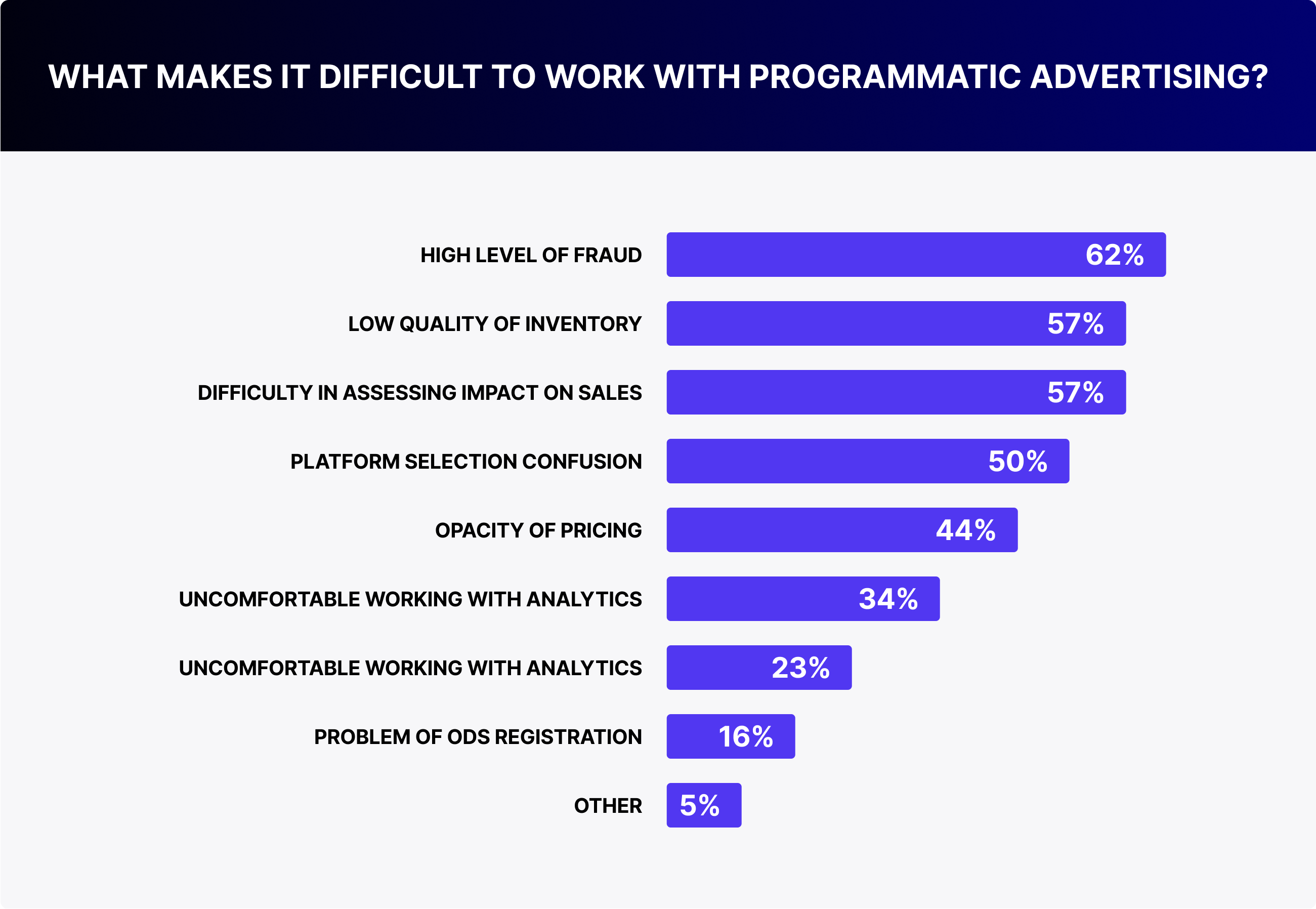
Transparency should be understood by some of its aspects as the correctness of customization and speed of advertising strategies and data.
What to do?
Transparency in the use of strategies and data provides access to comprehensive reports on targeting and ad customization, as well as real-time updates on campaign performance. The strategies transparency are made clear through the use of algorithms and change history.
Automated checks and tools, advice, and feedback from technical or customer support platforms enable us to ensure the correctness of customization. In terms of operational speed, this is guaranteed by the rapid processing of data and a user-friendly interface, as well as the use of AI to optimize and adapt campaigns in real time.
It is therefore advisable to select advertising platforms that provide transparency in reporting, offer proven customization methods, and have fast data processing speeds.
Programmatic is a complex ecosystem that requires a well-thought-out strategy, a solid grasp of the technology, and accurate analytics. The Russian market today offers a wide range of optionsб from independent DSPs to solutions integrated into telecom and media ecosystems.
To run programmatic campaigns effectively, it’s crucial not only to choose the right platform but also to build a strategy that aligns with your goals, ad formats, and available data.
If you need help selecting the best-fit solution or managing your campaign, RMAA experts are here to guide you and offer a hands-on approach. Just leave a request in the ‘Contacts’ section — we’ll get in touch with you shortly.
Join 2,000+
of your Peers!
You will be the first to know about Russian marketing insights, news and updates from our agency. Stay tuned!
Get our latest articles delivered to your email inbox and get our exclusive White Paper
"Digital Marketing in Russia. Finding your customers on the internet"
for FREE!
How does the Media Buying Market in Russia Work?
Navigating the Media Buying System in Russia
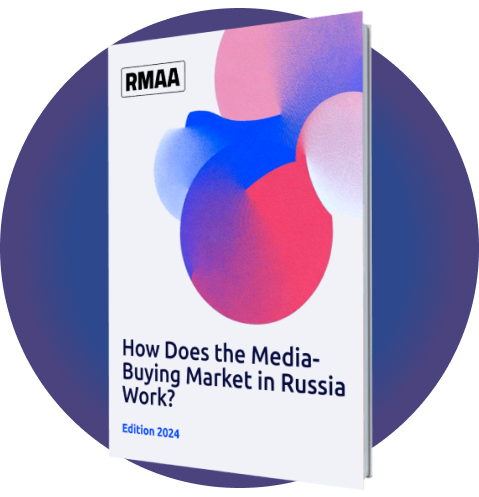
Ready to partner with the specialists in Russian marketing and advertising?
About the Author
Digital Strategist. Head of one of the project groups at RMAA. Maria started her journey in digital marketing in 2009.
Join 2,000+ of your Peers!
Get our latest articles delivered to your email inbox and get our exclusive White Paper "Digital Marketing in Russia. Finding your customers on the internet" for FREE!
You will be the first to know about Russian marketing insights,
news and updates from our agency.
Stay tuned!
We're updating our website's design step by step, so some pages may look different. Thank you for your understanding.
Got it














